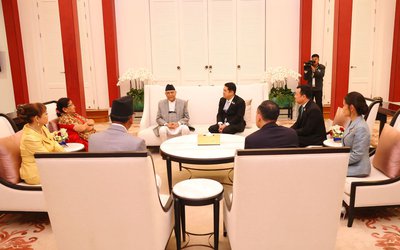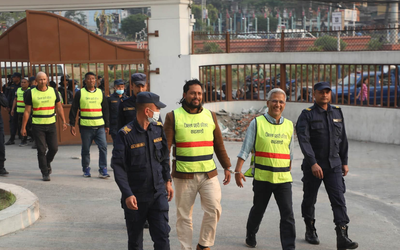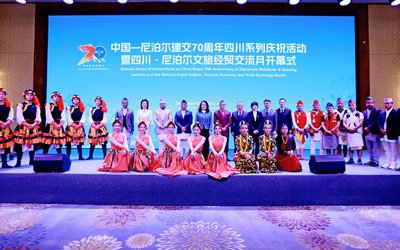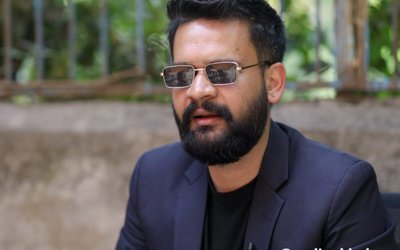More on News





BHUPENDRA BAHADUR BASNET, director general of the Department of Local Infrastructure Development and Agriculture Roads (DoLIDAR), has been working in the rural development sector for a long time. As the Department just celebrated fifteen years of its establishment, Basnet spoke to NEW SPOTLIGHT on various issues regarding the role of his department in the process of transformation of rural Nepal. Excerpts:
What is the rationale behind the establishment of the Department of Local Infrastructure Development and Agriculture Roads (DoLIDAR)?
The establishment of DoLIDAR has brought about massive transformation in rural parts of Nepal through construction of roads, drinking water and irrigation facilities and suspension bridges. One of the aims of the department is to provide technical support to local bodies. According to the Local Self Governance Act and corresponding regulations, the responsibility to construct rural infrastructure lies with two units, the local bodies and our department. As per the act, the large proportions of infrastructure and development projects go under the responsibility of local bodies like DDCs and VDCs. They require technical assistance.
What is the importance of the Department?
DoLIDAR has been experiencing many ups and downs during the last fifteen years. In the initial stage of its establishment, the department gave priority to rural roads, which are still one of the priority sectors. However, now the department has to look at different infrastructure development sectors. They include local transport infrastructure, road, motorable bridge, suspension bridge, drinking water, sanitation, micro-hydro, alternative energy management, small irrigation, river training and social infrastructure, which include temples, and archeological sites.
Which infrastructure has the high demand?
There is a high demand of roads and the department is also highly involved in rural road construction since the beginning of its existence. Our experiences have shown that the road is one of the important components of rural transformation. With support from the Asian Development Bank, we launched rural road projects in three districts initially. However, the department has done a miracle in the last fifteen years. The Agriculture Perspective Plan projected the need to construct over 6,200 kilometers of roads in the rural areas. However, it is estimated that 62,000 kilometers of rural roads are in the country now. More than 45,000 kilometers of rural road network has already been constructed with the government’s own resources. Out of this, 25 percent is serviceable. By the end of this fiscal year, we will have the actual data of all the rural roads. We have now district level road master plan and the department has already updated it. The master plan of rural roads of all 75 districts is there.
What about the irrigation and drinking water sectors?
An important component is drinking water. Under support from Finland, we have been implementing drinking water projects in far west, mid-west and western districts. Along with this, the government of Nepal allocates budgets for all 75 districts. Nepal is an agro-based country which needs adequate facilities to increase farm production. For a country whose 80 percent population relies on agriculture, it is impossible to transform the economy without development of the agriculture sector. Modernization of agriculture is impossible without increasing access to roads. Irrigation is another major component for the development of the agriculture sector. Under support from the Asian Development Bank, we are now launching small irrigation projects in 12 districts of far western region. We are also implementing small irrigation project with annual government budgets.
What is the aim of rural roads?
Our rural roads are not only roads. Their overall aim is poverty reduction. As there is a high demand of infrastructure, the government spends huge budgets in infrastructure. There is the need of infrastructure for service delivery. Roads are one of the important aspects of service delivery.
What are the challenges before the department?
Bringing the existing established road network into serviceable condition is a challenging task. For this, sufficient financial and qualified technical resources are required. We are now proposing the concerned stakeholders to opt for maintenance and construction of bridges in bringing the established road assets to serviceable condition. In the absence of elected local bodies for more than a decade, we are unable to update the information. As it is still uncertain when the election for local bodies are held, we have decided to update the master plan.
How do you see the involvement of Nepal’s development partners in all this?
Almost all development partners who have been working in Nepal in the area of infrastructure development, are involved with DoLIDAR. They include India, Japan, Finland, SDC, the World Bank, the Asian Development Bank, SDC of Switzerland, DfID, and UNICEF.
Where are Nepal’s development partners working now?
The World Bank is involved in rural development through its Rural Infrastructure Development Project, which was started as a pilot project. After its success and lessons learned, RAIDP has come up. We have been working in 30 districts through the Rural Area Infrastructure Development Project. The World Bank is involved in rural development through the RAIDP, which is now in another phase. RAIDP will continue till 2013 and we have already started negotiations to give continuity to this project. We are in the process of designing the new project. With support from ADB, DfID, SDC and OFID, Rural Reconstruction and Rehabilitation Project (RRRSDP) is working to rehabilitate the displaced people to their homes via fast tracks covering 18 districts. Similarly, the ADB is a major contributor in the rural infrastructure development project. Under the Asian Development Bank’s support, the Decentralized Rural Infrastructure and Livelihood Project (DRLP) has also been supporting the construction of infrastructure in 18 districts of Nepal. In the rural drinking water project, Finland government is supporting Rural Village Water Resource Management Project (RVWRMP in 10 districts of far west and mid-western region. This project helps the rural folks to manage water in various forms. Finland is also running RWSSP in nine district of western region with a center in Pokhara. With support from DfID, it is implementing the Rural Access Program 2nd phase and the SDC is supporting the District Road Supporting Program. Similarly, Swiss Government, Japan government and DfID are supporting the Trail Bridge Sector Wide and Local Level Rural Road Bridge Program, UNICEF is supporting Rural Water Supply and Sanitation Program, Japan is supporting Rural Road Bridge Program and ADB is supporting community Irrigation project.
What approach are you following now?
It is a Sector Wise approach (SWAp). We have already implemented the SWAp in transport sector and are now planning to apply this to six other sectors. From selection, to implementation of the program, there is only one institution involved to reduce the cost overrun and duplicity and lengthy procedures.
What difference does SWAp make?
Earlier there used to be different models of suspension bridge for different agencies. After the implementation of SWAp, there will be only one design and easy procedures for all now. This will help develop a holistic approach, which includes the budget, project design and project construction.
How do you address the quality issue?
The issue of quality needs to be addressed now as people have now misunderstood the issue of quality of rural roads and highways. The rural roads are constructed to run the vehicles with 10 tons. However, people want to run the vehicles with more weights. The cost of rural road is much cheaper than that of the highways. The time has come to define quality. Quality of the project will be determined by our budget and expenditure in the project. It depends on the specifications. However, there is a misunderstanding about specifications. Our road is capable to carry 8 to 10 tons, unlike the Bhaktapur-Koteshwor road. I agree that we are also unable to maintain quality in some instances.
What are the modalities in working?
We have now two modalities to work at local level with consumer groups and local bodies. Most of the work is done by consumer groups. We need to create a momentum in the early stage. Here, we also emphasize the quality issue. In the early stage, we ignore the issue of quality to create the momentum and now we have to look at the issue of quality. If we make roads as per the specifications for other highways, the cost will go high. However, the rural roads have less budgets. I agree that we are unable to maintain quality.
How do you see the process of transformation of the department?
We are now working to change earthen roads into blacktopped ones and encouraging farmers to use pumps to supply water. We are acquiring water from pumping. We are now in the process of constructing the bridges on motor able roads with a span of up to 200 meters. We are now constructing 100 bridges. We constructed the longest suspension bridge in Dodhara Chandani in Kanchanpur. We have also constructed the highest suspension bridge in Parbat. Similarly, we have already constructed motorable suspension bridge in Parbat. We are now on the construction stage of a 100-meter long suspension motorable bridge. We are constructing more than 100 long bridges to link Bardia and Banke in Mahana river. From small scale, now we are moving to larger scales.
Again, how do you control the quality?
We are now working to maintain quality control as the time has come for quality assurance. We want to maintain quality through day to day supervision and other tests. We are planning to establish a laboratory in each district to check quality. In 19 districts, there are water quality test labs for which we have provided some equipment. The aim is to maintain the quality of water supply. There is a mobile lab which can tell the level of elements in the water. Similarly, in the road sector, we are now working to establish labs in all 75 districts as RAIDP has quality labs in 30 districts. RRR has 20 districts. We have made agreements with the DDC so that it will appoint a technician. We are yet to establish labs in remaining 25 districts. In some areas, most of the labs are not functioning. The roads failed because of lack of compaction. Of course, low quality materials are responsible to some extent for the failure, but it is compaction which is responsible for the present situation.
What other things does your department do?
Along with the hardware part, we have also the software part which includes enhancing capacity of DDC employees and institutions. At a time when there is an increase of 10 folds in roads, the number of employees remains the same. DDCs have so many projects scattered in various regions. However, there are many projects where there is not even a technician. There is a need to increase the manpower at the local level and the central agencies need to play more role in this. Even the development partners are raising concerns on the massive malpractices at the local level.
How do you view the gap between demand and supply?
There is a huge gap between demand and supply. In rural areas, the cost of infrastructure is very expensive. You can set up drinking water project in the terai just by investing 15,000 rupees, whereas it will cost Rs. 3 million in hills and mountains. The same situation is there in the case of roads. There is a gap in resources in comparison with contribution of development partners. There is the need to guarantee that they will receive funds. People need assurance that they will receive funds for development projects. We also need to prioritize the projects. Still, we have made a tremendous progress in road and drinking water sectors.






